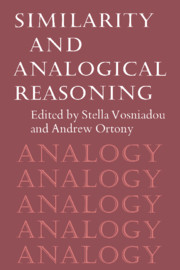Book contents
- Frontmatter
- Contents
- Preface
- List of contributors
- Similarity and analogical reasoning: a synthesis
- Part I Similarity and the structure of concepts
- 1 Similarity, typicality, and categorization
- 2 Similarity and decision making
- 3 Intraconcept similarity and its implications for interconcept similarity
- 4 Two-tiered concept meaning, inferential matching, and conceptual cohesiveness
- 5 From global similarities to kinds of similarities: the construction of dimensions in development
- 6 Comments on Part I: Psychological essentialism
- Part II Analogical reasoning
- Part III Similarity and analogy in development, learning, and instruction
- Afterword: Comments on Parts I, II, and III: A framework for a theory of comparison and mapping
- Name index
- Subject index
6 - Comments on Part I: Psychological essentialism
Published online by Cambridge University Press: 22 October 2009
- Frontmatter
- Contents
- Preface
- List of contributors
- Similarity and analogical reasoning: a synthesis
- Part I Similarity and the structure of concepts
- 1 Similarity, typicality, and categorization
- 2 Similarity and decision making
- 3 Intraconcept similarity and its implications for interconcept similarity
- 4 Two-tiered concept meaning, inferential matching, and conceptual cohesiveness
- 5 From global similarities to kinds of similarities: the construction of dimensions in development
- 6 Comments on Part I: Psychological essentialism
- Part II Analogical reasoning
- Part III Similarity and analogy in development, learning, and instruction
- Afterword: Comments on Parts I, II, and III: A framework for a theory of comparison and mapping
- Name index
- Subject index
Summary
What is common to them all? – Don't say: “There must be something common, or they would not be called ‘games’ ” – but look and see whether there is anything common to all. – For if you look at them you will not see something that is common to all, but similarities, relationships, and a whole series of them at that. To repeat: don't think, but look!
Wittgenstein, Philosophical InvestigationsWittgenstein's admonition “don't think, but look” has had the important effect of stimulating psychologists to reconsider their common practice of equating concept formation with the learning of simple definitional rules. In the early 1970s, psychologists like Eleanor Rosch (e.g., Rosch, 1973), responding to the difficulty of identifying necessary and sufficient conditions for membership of all kinds of categories, proposed alternative models of category representation based on clusters of correlated features related to the categories only probabilistically. Without denying the importance and impact of this changed view of concepts (reviewed, e.g., by Smith & Medin, 1981), we think that in certain respects the “don't think, but look” advice may have been taken too literally. There are problems with equating concepts with undifferentiated clusters of properties and with abandoning the idea that category membership may depend on intrinsically important, even if relatively inaccessible, features. For example, on the basis of readily accessible properties that can be seen, people presumably will not judge whales to be very similar to other mammals. However, if they think about the fact that whales are mammals not fish, they will probably acknowledge that with respect to some important, although less accessible property or properties whales are similar to other mammals.
- Type
- Chapter
- Information
- Similarity and Analogical Reasoning , pp. 179 - 196Publisher: Cambridge University PressPrint publication year: 1989
- 502
- Cited by

